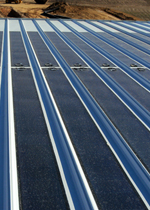- Low maintenance during its more than 40 year lifespan.
- Durability for wind, fire, hail and U.V.
- Virtually 100% recyclable, allowing for reduced landfill mass and comprised of 25% to 35% post-consumer recycled steel.
- Cool roof colors of metal panel systems.
- Unsurpassed warranties compared to both conventional roofing companies and solar module manufacturers.
Solar
- An ecological resource with a low carbon footprint that harnesses the sun’s renewable energy.
- A sustainable resource that will produce 85% of rated energy production 20 years after installation.
- A diverse resource, available in a variety of technologies including modules of polycrystalline and thin film.
- A reliable resource, producing energy anywhere the sun shines at a fixed and known cost that is not subject to the fluctuation of fuel costs and utility rate escalations.
The Perfect Blend
The combination of metal roofing systems with PV systems provides a number of benefits for the building owner. Below is a breakdown of the support to these benefits:
- The PV system’s efficiency typically improves when it’s installed on a cool metal roof increasing the energy output of the solar modules.
- The solar modules can be installed on a metal roof system with no penetrations into the roof, allowing the metal roofing warranty to remain intact.
- Nearly 80% of PV installations occur on existing construction. The service life of a metal roof system is compatible with that of a solar array.
- PV systems typically last 20-25 years. Why install a system on a roof that will only last 15-20 years? Instead, choose a Star metal roof that will last 40 years or more, allowing you to remove the existing solar array to install a new one on the same roof.



